Role of Microfinance and Informal Finance in Stabilizing Saudi Economy
VerifiedAdded on 2023/01/20
|6
|1185
|32
Report
AI Summary
This report examines the role of microfinance and informal finance in stabilizing the Saudi Arabian economy. It begins with an introduction to microfinance, its importance for small businesses, and the emergence of informal financial sectors. The background section discusses microfinance's role in providing financial support to underserved populations and MSMEs in Saudi Arabia. The literature review explores the potential of Islamic finance in maintaining economic stability, the evolution of microfinance, and its impact on both the poor and small businesses. The report also discusses the concept of Islamic microfinance, which incorporates environmental considerations. Furthermore, it highlights the role of microfinance in making the financial sector more inclusive and its development in countries like Bangladesh. The report assesses the impact of microfinance and informal finance in the financial sector of Saudi Arabia.
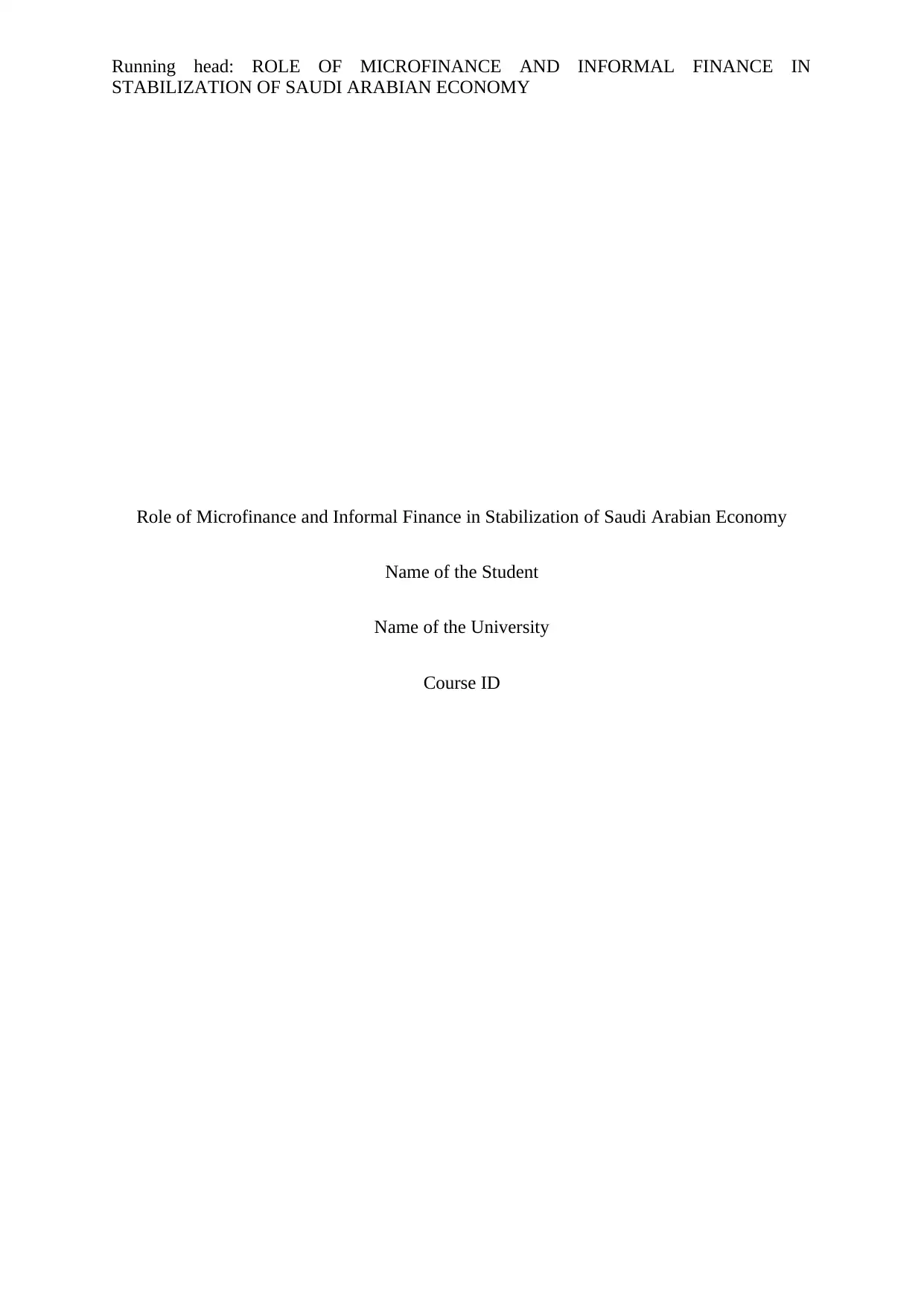
Running head: ROLE OF MICROFINANCE AND INFORMAL FINANCE IN
STABILIZATION OF SAUDI ARABIAN ECONOMY
Role of Microfinance and Informal Finance in Stabilization of Saudi Arabian Economy
Name of the Student
Name of the University
Course ID
STABILIZATION OF SAUDI ARABIAN ECONOMY
Role of Microfinance and Informal Finance in Stabilization of Saudi Arabian Economy
Name of the Student
Name of the University
Course ID
Paraphrase This Document
Need a fresh take? Get an instant paraphrase of this document with our AI Paraphraser
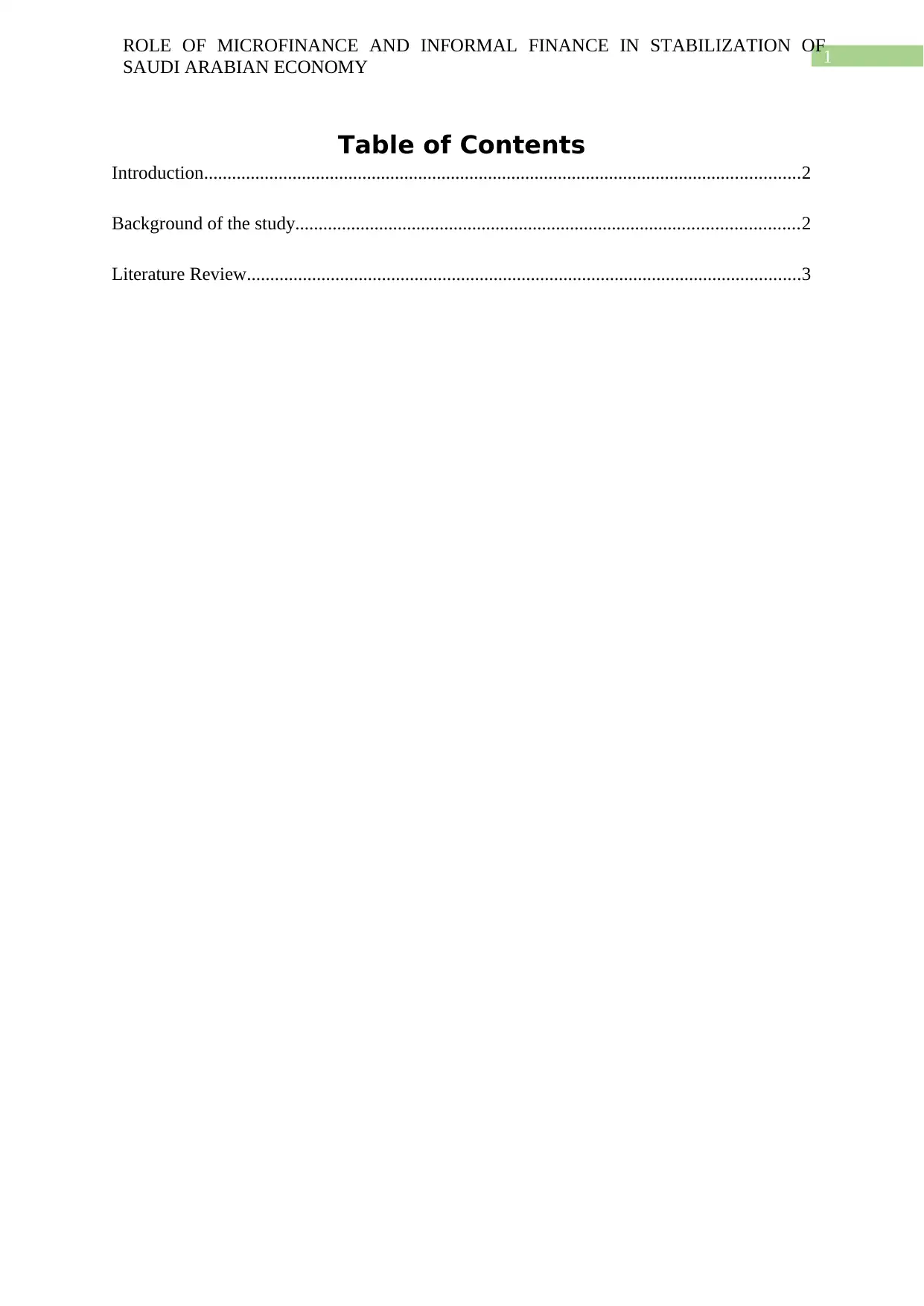
1
ROLE OF MICROFINANCE AND INFORMAL FINANCE IN STABILIZATION OF
SAUDI ARABIAN ECONOMY
Table of Contents
Introduction................................................................................................................................2
Background of the study............................................................................................................2
Literature Review.......................................................................................................................3
ROLE OF MICROFINANCE AND INFORMAL FINANCE IN STABILIZATION OF
SAUDI ARABIAN ECONOMY
Table of Contents
Introduction................................................................................................................................2
Background of the study............................................................................................................2
Literature Review.......................................................................................................................3
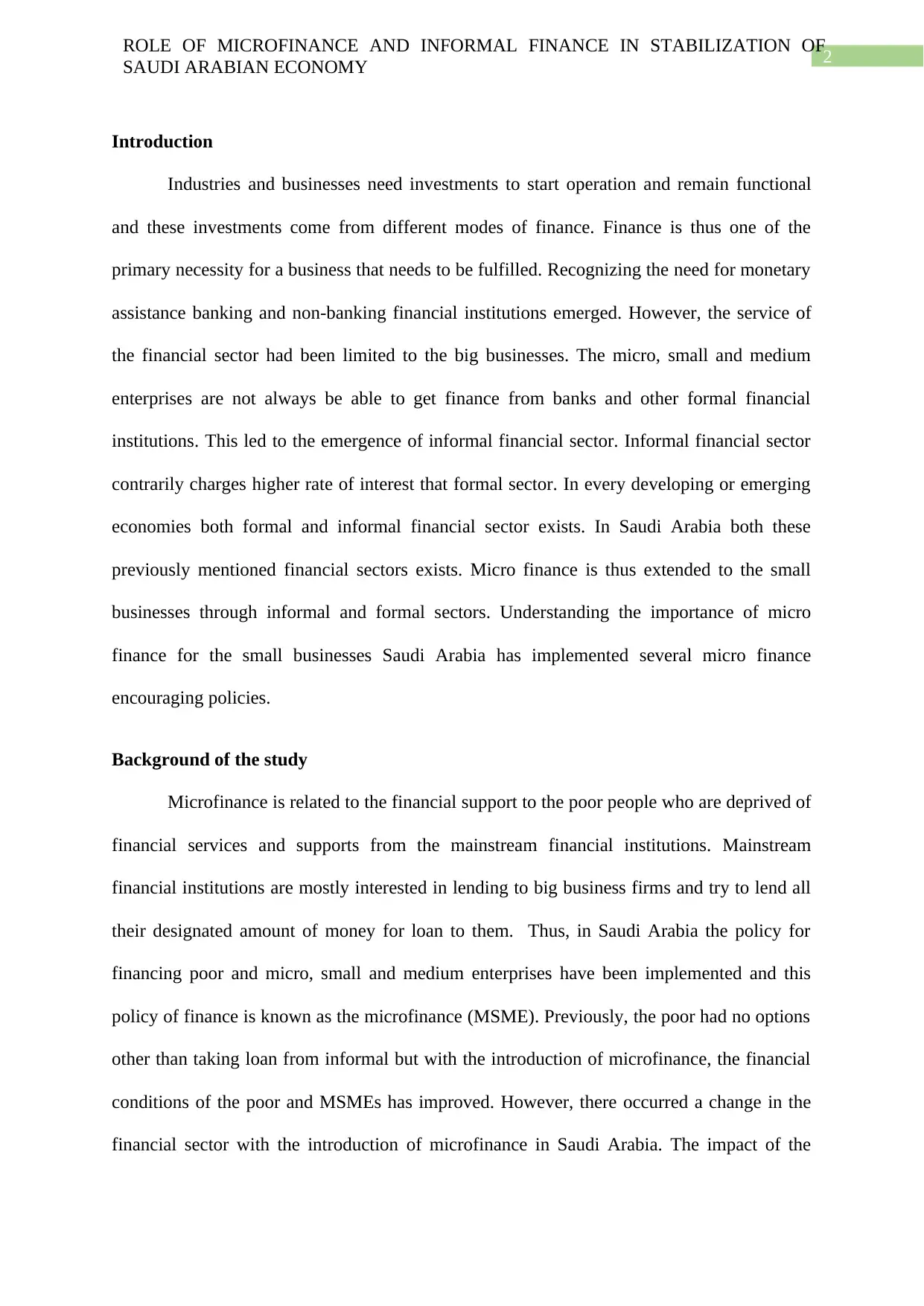
2
ROLE OF MICROFINANCE AND INFORMAL FINANCE IN STABILIZATION OF
SAUDI ARABIAN ECONOMY
Introduction
Industries and businesses need investments to start operation and remain functional
and these investments come from different modes of finance. Finance is thus one of the
primary necessity for a business that needs to be fulfilled. Recognizing the need for monetary
assistance banking and non-banking financial institutions emerged. However, the service of
the financial sector had been limited to the big businesses. The micro, small and medium
enterprises are not always be able to get finance from banks and other formal financial
institutions. This led to the emergence of informal financial sector. Informal financial sector
contrarily charges higher rate of interest that formal sector. In every developing or emerging
economies both formal and informal financial sector exists. In Saudi Arabia both these
previously mentioned financial sectors exists. Micro finance is thus extended to the small
businesses through informal and formal sectors. Understanding the importance of micro
finance for the small businesses Saudi Arabia has implemented several micro finance
encouraging policies.
Background of the study
Microfinance is related to the financial support to the poor people who are deprived of
financial services and supports from the mainstream financial institutions. Mainstream
financial institutions are mostly interested in lending to big business firms and try to lend all
their designated amount of money for loan to them. Thus, in Saudi Arabia the policy for
financing poor and micro, small and medium enterprises have been implemented and this
policy of finance is known as the microfinance (MSME). Previously, the poor had no options
other than taking loan from informal but with the introduction of microfinance, the financial
conditions of the poor and MSMEs has improved. However, there occurred a change in the
financial sector with the introduction of microfinance in Saudi Arabia. The impact of the
ROLE OF MICROFINANCE AND INFORMAL FINANCE IN STABILIZATION OF
SAUDI ARABIAN ECONOMY
Introduction
Industries and businesses need investments to start operation and remain functional
and these investments come from different modes of finance. Finance is thus one of the
primary necessity for a business that needs to be fulfilled. Recognizing the need for monetary
assistance banking and non-banking financial institutions emerged. However, the service of
the financial sector had been limited to the big businesses. The micro, small and medium
enterprises are not always be able to get finance from banks and other formal financial
institutions. This led to the emergence of informal financial sector. Informal financial sector
contrarily charges higher rate of interest that formal sector. In every developing or emerging
economies both formal and informal financial sector exists. In Saudi Arabia both these
previously mentioned financial sectors exists. Micro finance is thus extended to the small
businesses through informal and formal sectors. Understanding the importance of micro
finance for the small businesses Saudi Arabia has implemented several micro finance
encouraging policies.
Background of the study
Microfinance is related to the financial support to the poor people who are deprived of
financial services and supports from the mainstream financial institutions. Mainstream
financial institutions are mostly interested in lending to big business firms and try to lend all
their designated amount of money for loan to them. Thus, in Saudi Arabia the policy for
financing poor and micro, small and medium enterprises have been implemented and this
policy of finance is known as the microfinance (MSME). Previously, the poor had no options
other than taking loan from informal but with the introduction of microfinance, the financial
conditions of the poor and MSMEs has improved. However, there occurred a change in the
financial sector with the introduction of microfinance in Saudi Arabia. The impact of the
⊘ This is a preview!⊘
Do you want full access?
Subscribe today to unlock all pages.

Trusted by 1+ million students worldwide
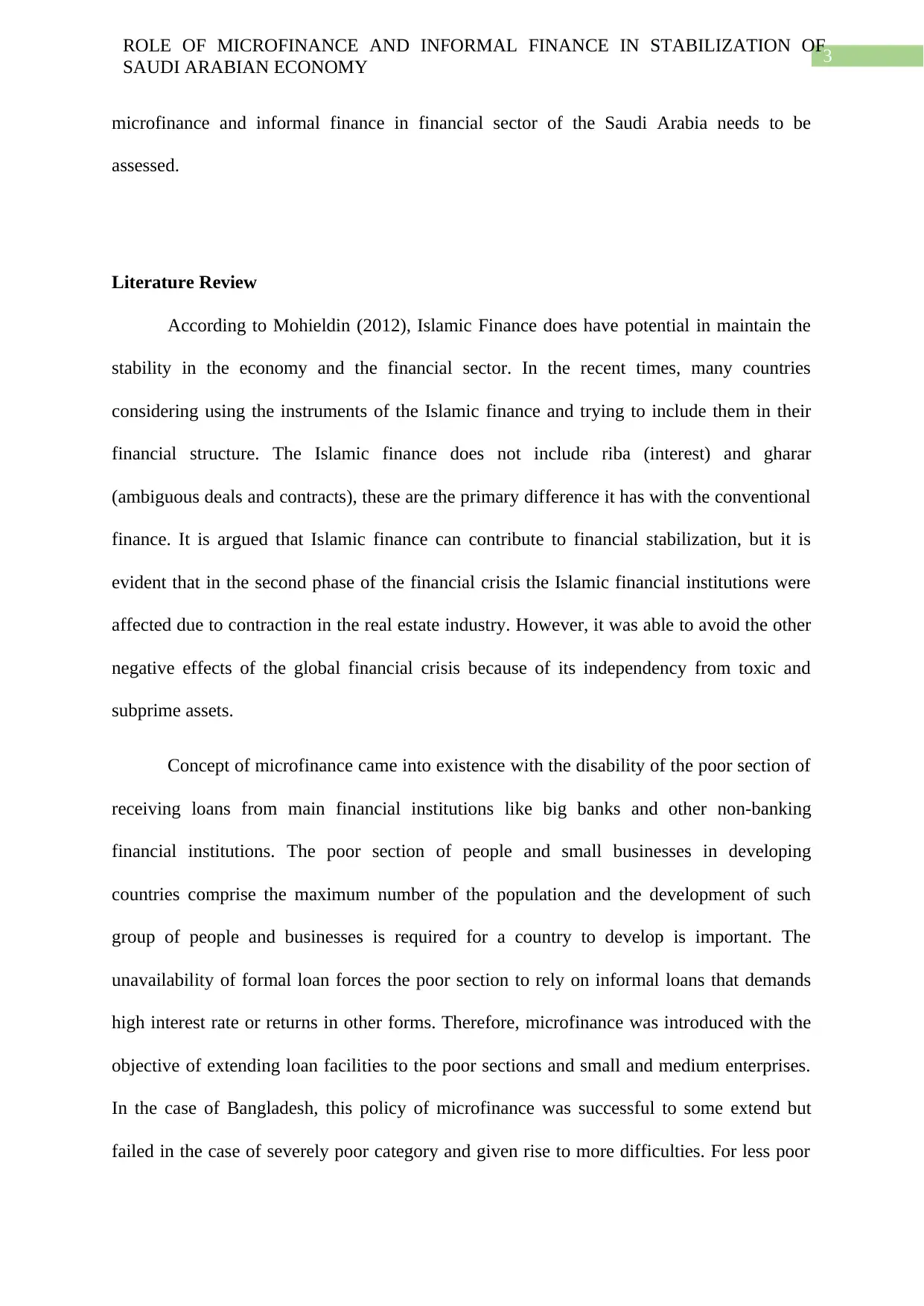
3
ROLE OF MICROFINANCE AND INFORMAL FINANCE IN STABILIZATION OF
SAUDI ARABIAN ECONOMY
microfinance and informal finance in financial sector of the Saudi Arabia needs to be
assessed.
Literature Review
According to Mohieldin (2012), Islamic Finance does have potential in maintain the
stability in the economy and the financial sector. In the recent times, many countries
considering using the instruments of the Islamic finance and trying to include them in their
financial structure. The Islamic finance does not include riba (interest) and gharar
(ambiguous deals and contracts), these are the primary difference it has with the conventional
finance. It is argued that Islamic finance can contribute to financial stabilization, but it is
evident that in the second phase of the financial crisis the Islamic financial institutions were
affected due to contraction in the real estate industry. However, it was able to avoid the other
negative effects of the global financial crisis because of its independency from toxic and
subprime assets.
Concept of microfinance came into existence with the disability of the poor section of
receiving loans from main financial institutions like big banks and other non-banking
financial institutions. The poor section of people and small businesses in developing
countries comprise the maximum number of the population and the development of such
group of people and businesses is required for a country to develop is important. The
unavailability of formal loan forces the poor section to rely on informal loans that demands
high interest rate or returns in other forms. Therefore, microfinance was introduced with the
objective of extending loan facilities to the poor sections and small and medium enterprises.
In the case of Bangladesh, this policy of microfinance was successful to some extend but
failed in the case of severely poor category and given rise to more difficulties. For less poor
ROLE OF MICROFINANCE AND INFORMAL FINANCE IN STABILIZATION OF
SAUDI ARABIAN ECONOMY
microfinance and informal finance in financial sector of the Saudi Arabia needs to be
assessed.
Literature Review
According to Mohieldin (2012), Islamic Finance does have potential in maintain the
stability in the economy and the financial sector. In the recent times, many countries
considering using the instruments of the Islamic finance and trying to include them in their
financial structure. The Islamic finance does not include riba (interest) and gharar
(ambiguous deals and contracts), these are the primary difference it has with the conventional
finance. It is argued that Islamic finance can contribute to financial stabilization, but it is
evident that in the second phase of the financial crisis the Islamic financial institutions were
affected due to contraction in the real estate industry. However, it was able to avoid the other
negative effects of the global financial crisis because of its independency from toxic and
subprime assets.
Concept of microfinance came into existence with the disability of the poor section of
receiving loans from main financial institutions like big banks and other non-banking
financial institutions. The poor section of people and small businesses in developing
countries comprise the maximum number of the population and the development of such
group of people and businesses is required for a country to develop is important. The
unavailability of formal loan forces the poor section to rely on informal loans that demands
high interest rate or returns in other forms. Therefore, microfinance was introduced with the
objective of extending loan facilities to the poor sections and small and medium enterprises.
In the case of Bangladesh, this policy of microfinance was successful to some extend but
failed in the case of severely poor category and given rise to more difficulties. For less poor
Paraphrase This Document
Need a fresh take? Get an instant paraphrase of this document with our AI Paraphraser
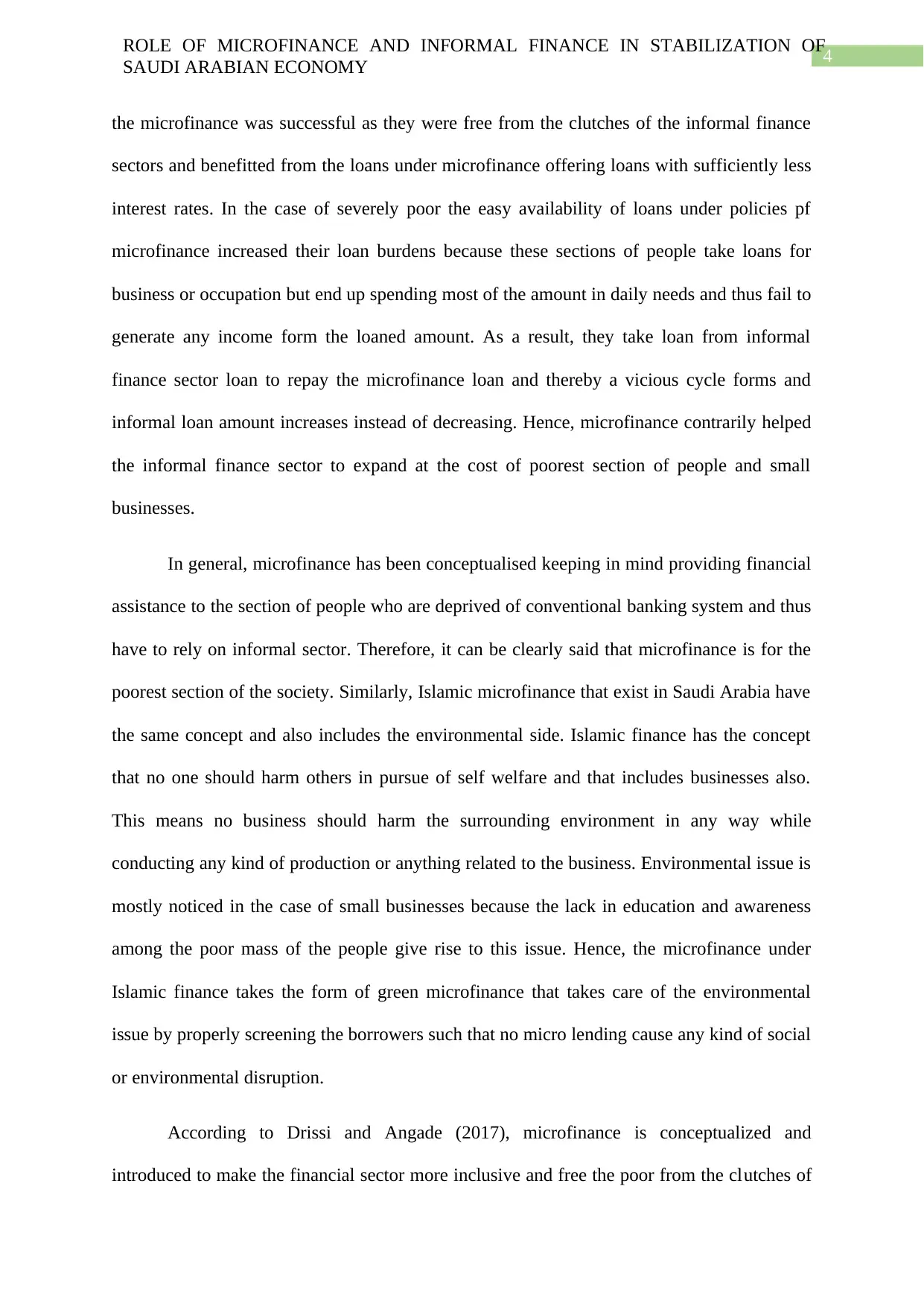
4
ROLE OF MICROFINANCE AND INFORMAL FINANCE IN STABILIZATION OF
SAUDI ARABIAN ECONOMY
the microfinance was successful as they were free from the clutches of the informal finance
sectors and benefitted from the loans under microfinance offering loans with sufficiently less
interest rates. In the case of severely poor the easy availability of loans under policies pf
microfinance increased their loan burdens because these sections of people take loans for
business or occupation but end up spending most of the amount in daily needs and thus fail to
generate any income form the loaned amount. As a result, they take loan from informal
finance sector loan to repay the microfinance loan and thereby a vicious cycle forms and
informal loan amount increases instead of decreasing. Hence, microfinance contrarily helped
the informal finance sector to expand at the cost of poorest section of people and small
businesses.
In general, microfinance has been conceptualised keeping in mind providing financial
assistance to the section of people who are deprived of conventional banking system and thus
have to rely on informal sector. Therefore, it can be clearly said that microfinance is for the
poorest section of the society. Similarly, Islamic microfinance that exist in Saudi Arabia have
the same concept and also includes the environmental side. Islamic finance has the concept
that no one should harm others in pursue of self welfare and that includes businesses also.
This means no business should harm the surrounding environment in any way while
conducting any kind of production or anything related to the business. Environmental issue is
mostly noticed in the case of small businesses because the lack in education and awareness
among the poor mass of the people give rise to this issue. Hence, the microfinance under
Islamic finance takes the form of green microfinance that takes care of the environmental
issue by properly screening the borrowers such that no micro lending cause any kind of social
or environmental disruption.
According to Drissi and Angade (2017), microfinance is conceptualized and
introduced to make the financial sector more inclusive and free the poor from the clutches of
ROLE OF MICROFINANCE AND INFORMAL FINANCE IN STABILIZATION OF
SAUDI ARABIAN ECONOMY
the microfinance was successful as they were free from the clutches of the informal finance
sectors and benefitted from the loans under microfinance offering loans with sufficiently less
interest rates. In the case of severely poor the easy availability of loans under policies pf
microfinance increased their loan burdens because these sections of people take loans for
business or occupation but end up spending most of the amount in daily needs and thus fail to
generate any income form the loaned amount. As a result, they take loan from informal
finance sector loan to repay the microfinance loan and thereby a vicious cycle forms and
informal loan amount increases instead of decreasing. Hence, microfinance contrarily helped
the informal finance sector to expand at the cost of poorest section of people and small
businesses.
In general, microfinance has been conceptualised keeping in mind providing financial
assistance to the section of people who are deprived of conventional banking system and thus
have to rely on informal sector. Therefore, it can be clearly said that microfinance is for the
poorest section of the society. Similarly, Islamic microfinance that exist in Saudi Arabia have
the same concept and also includes the environmental side. Islamic finance has the concept
that no one should harm others in pursue of self welfare and that includes businesses also.
This means no business should harm the surrounding environment in any way while
conducting any kind of production or anything related to the business. Environmental issue is
mostly noticed in the case of small businesses because the lack in education and awareness
among the poor mass of the people give rise to this issue. Hence, the microfinance under
Islamic finance takes the form of green microfinance that takes care of the environmental
issue by properly screening the borrowers such that no micro lending cause any kind of social
or environmental disruption.
According to Drissi and Angade (2017), microfinance is conceptualized and
introduced to make the financial sector more inclusive and free the poor from the clutches of

5
ROLE OF MICROFINANCE AND INFORMAL FINANCE IN STABILIZATION OF
SAUDI ARABIAN ECONOMY
the informal lenders that charges high returns on loans. The main purpose of the microfinance
is to develop the deprived class of people and businessperson by providing collateral free
loans. To support the process of microfinance, specialized banks that look after the
microfinance lending systems have been established in the developing countries. After
independence of Bangladesh in 1971 it had been facing severe crisis as 80 percent of the
population was below the poverty line, and the process of providing loans to the poor under
the name of microfinance was introduced. Thus, it did brought revolution in the area of
finance and disseminates the concept of finance policies can influence the social factors
directly.
ROLE OF MICROFINANCE AND INFORMAL FINANCE IN STABILIZATION OF
SAUDI ARABIAN ECONOMY
the informal lenders that charges high returns on loans. The main purpose of the microfinance
is to develop the deprived class of people and businessperson by providing collateral free
loans. To support the process of microfinance, specialized banks that look after the
microfinance lending systems have been established in the developing countries. After
independence of Bangladesh in 1971 it had been facing severe crisis as 80 percent of the
population was below the poverty line, and the process of providing loans to the poor under
the name of microfinance was introduced. Thus, it did brought revolution in the area of
finance and disseminates the concept of finance policies can influence the social factors
directly.
⊘ This is a preview!⊘
Do you want full access?
Subscribe today to unlock all pages.

Trusted by 1+ million students worldwide
1 out of 6
Related Documents
Your All-in-One AI-Powered Toolkit for Academic Success.
+13062052269
info@desklib.com
Available 24*7 on WhatsApp / Email
![[object Object]](/_next/static/media/star-bottom.7253800d.svg)
Unlock your academic potential
Copyright © 2020–2025 A2Z Services. All Rights Reserved. Developed and managed by ZUCOL.





